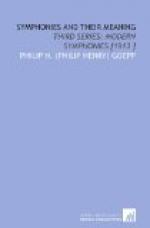followed and accompanied by an expressive answer in the strings. On the wing of this song we rise to a height where begins the path of a brief nervous motive (of the first notes of the symphony) that with the descending tone abounds in various guise. As a bold glance at the sun is punished by a sight of solar figures all about, so we feel throughout the tonal story the presence of these symbols. An epilogue of wistful song leads to the repeated melodies.
The main figure of the plot that follows is the first melody, now in slow, graceful notes, now in feverish pace, though the brief (second) motive moves constantly here and there. A darkest descent follows into an Avernus of deep brooding on the legend, with an ascending path of the brief, nervous phrase and a reverse fall, that finally wears out its own despair and ends in a sombre verse of the prelude, with new shades of melancholy, then plunges into an overwhelming burst on the sighing phrase. Thence the path of brooding begins anew; but it is now ascendant, on the dual pulse of the poignant motto and the brief, nervous motive. The whole current of passion is thus uttered in the prelude strain that at the outset was pregnant with feeling. At the crisis it is answered or rather interwoven with a guise of the second theme, in hurried pace, chanted by stentorian brass and wood in hallooing chorus that reaches a high exultation. To be sure the Russian at his gladdest seems tinged with sense of fate. So from the single burst we droop again. But the gloom is pierced by brilliant shafts,—herald calls (of brass and wood) that raise the mood of the returning main melody, and in their continuous refrain add a buoyant stimulus. And the verse of quicker figures has a new fire and ferment. All absent is the former descent of minor tones. Instead, in solemn hush of tempest, without the poignant touch, the tranquil second melody returns with dulcet answer of strings. A loveliest verse is of this further song where, in a dual chase of tune, the melody moves in contained rapture. In the cadence is a transfigured phase of the ascending tone, mingled with the retiring melody, all woven to a soothing cadence.
But the struggle is not over, nor is redemption near. The dulcet phrases sink once more to sombre depth where there is a final, slow-gathering burst of passion on the motto, with a conclusive ring almost of fierce triumph.
II.—The second movement, Allegro molto, is a complete change from introspection and passion to an
[Music: Allegro molto (Insistent strum of strings) Marcato]
abandon as of primitive dance. Strings stir the feet; the horns blow the first motive of the savage tune; the upper wood fall in with a dashing jingle,—like a stroke of cymbals across the hostile harmonies.
Whether a recurring idiom is merely personal or belongs to the special work is difficult to tell. In reality it matters little. Here the strange rising tone is the same as in the former (second) melody. In the rude vigor of harmonies the primitive idea is splendidly stressed.




